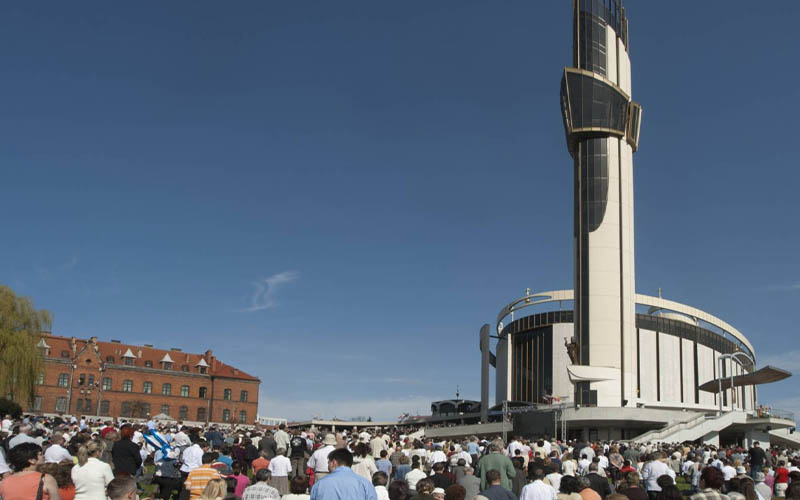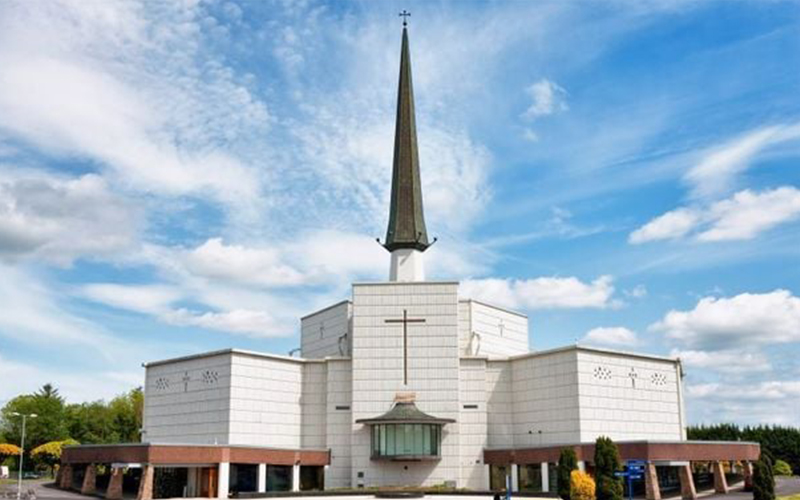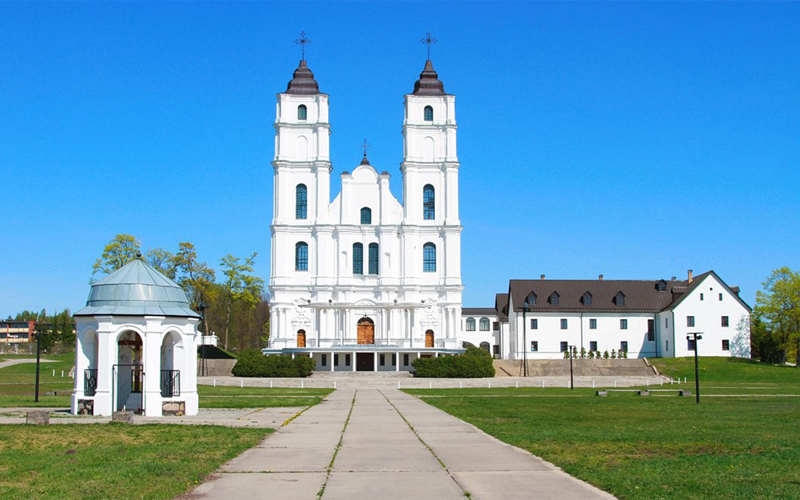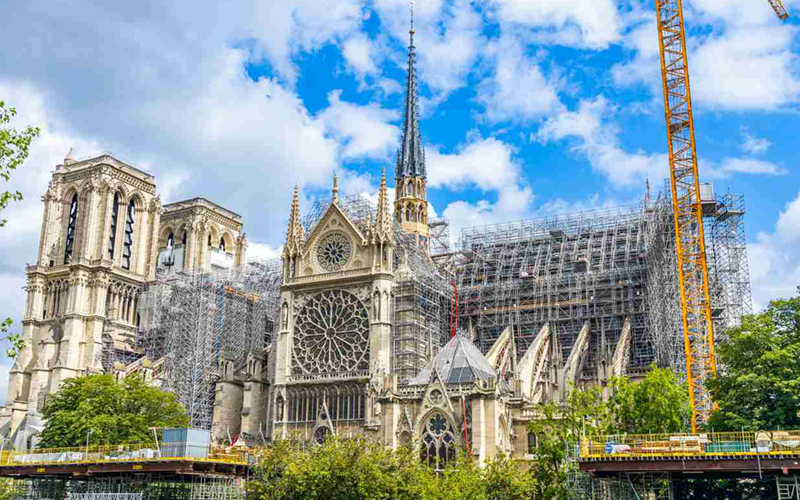Famous Catholic holy shrines worldwide include the Basilica of Our Lady of Guadalupe in Mexico, the Sanctuary of Our Lady of Lourdes in France, and the Vatican City in Rome, which houses St. Peter's Basilica. Other prominent shrines are in Fátima, Portugal; the Holy Land, particularly Nazareth and Jerusalem; Santiago de Compostela, Spain; and the Jasna Góra Monastery in Poland.Other prominent sites are the Basilica of Our Lady of Guadalupe in Mexico, the Cathedral of Santiago de Compostela in Spain, and Medjugorje in Bosnia and Herzegovina.

St. Peter's Basilica is a Renaissance-style church located in Vatican City, an independent city-state enclave within Rome, Italy. Considered one of the most famous religious buildings in the world, it is the largest Catholic church globally and holds immense significance as a pilgrimage site. It is built on the traditional site of Saint Peter's burial and features renowned artworks like Michelangelo's Pietà and Bernini's Baldachin.Peter's Basilica is one of the holiest churches in Christendom. The Basilica is dedicated to the martyrdom of Saint Peter, one of the twelve apostles of Jesus Christ. A classic example of Renaissance-style architecture, St. Peter's Basilica is on the bucket list of every traveler visiting Rome.The basilica was called St Peter's after one of Jesus's twelve disciples known as Saint Peter, who became one of the founders of the Catholic Church and was executed in Rome and buried where the Basilica now stands.

St. Mark's Basilica in Venice is an iconic Byzantine-style cathedral known for its opulent gold mosaics, stunning domes, and intricate marble floors. Located in the heart of Piazza San Marco, it is a major tourist attraction and a significant religious and cultural landmark.St. Mark's Basilica is famous for its stunning architecture, intricate mosaics, and rich history.Saint Mark's relics, the remains of Mark the Evangelist, have been held in St Mark's Basilica in Venice, Italy since being taken from Alexandria in the ninth century AD. It is renowned for housing the relics of Saint Mark the Evangelist, making it an important pilgrimage site in Christianity.Mark became a martyr after two days of excruciating torture. Although he ministered and died in Alexandria, his remains ultimately ended up in Venice, with the Basilica San Marco serving as a shrine in honor of this apostle to this day.

Santiago de Compostela is the capital of Galicia, Spain, and a UNESCO World Heritage Site famous as the final destination of the Camino de Santiago pilgrimage. It is believed to be the burial site of the apostle St. James the Great, whose remains are said to be in its cathedral, a major tourist and spiritual attraction since the 9th century. The city is also a vibrant university town with a rich history, medieval architecture, and a lively cultural scene.It is the endpoint of the Camino de Santiago, a pilgrimage route followed by thousands of people for centuries. The city is the burial place of the apostle St. James the Great, and his remains are believed to be in the city's cathedral.The Camino de Santiago (Way of St. James) is a network of pilgrimage routes through Europe that all end at the Cathedral of Santiago de Compostela in Spain, where the bones of St. James the Apostle are believed to be buried. Today, hundreds of thousands of people, for religious, spiritual, or cultural reasons, walk or cycle the paths each year, with popular routes including the French Way and the Northern Way.

The Sanctuary of Divine Mercy (Sanktuarium Bożego Miłosierdzia) in Kraków is a major Catholic pilgrimage site located in the city's Łagiewniki district. It is the resting place of Saint Faustina Kowalska, a Polish nun whose visions of Jesus inspired the Divine Mercy devotion. The site includes both a modern basilica and the original convent where St. Faustina lived and died.A Divine Mercy pilgrimage to Krakow, Poland, centers on the Sanctuary of the Divine Mercy in Łagiewniki, which is the burial place of St. Faustina. It includes visiting the chapel with the original "Merciful Jesus" painting, seeing the relics of St. Faustina, and experiencing daily devotion at 3 p.m. during the Hour of Mercy. The pilgrimage can also include other sites related to St. Faustina and Pope John Paul II, such as his childhood church and former residence.Many Catholic tour operators offer packages that include these sites, sometimes as part of a larger tour of Poland that includes places like Częstochowa and Warsaw.The largest annual celebration is on the first Sunday after Easter, with special vigils and celebrations for Divine Mercy Sunday.

Knock Shrine, in County Mayo, is an International Eucharistic and Marian Shrine and one of Ireland's most important pilgrimage destinations. The site gained prominence after a reported apparition of the Blessed Virgin Mary, St. Joseph, St. John the Evangelist, and the Lamb of God in 1879. The main pilgrimage season runs from the last Sunday in April to the second Sunday in October.Built in 1976, this modern church was elevated to a basilica by Pope John Paul II during his 1979 visit. It features one of Europe's largest mosaics, illustrating the Knock apparition.The shrine offers daily religious services and runs special programs throughout the year.Mass is celebrated daily in the Parish Church and Basilica. Confessions are also available daily in the Chapel of Reconciliation.The shrine grounds and many buildings are wheelchair accessible. A free shuttle service is available to transport pilgrims.On this date in history (August 21, 1879), fifteen people in the small village of Knock, Ireland, witnessed something truly miraculous on a rainy evening. As they looked toward the local church, they saw an apparition of the Virgin Mary, St. Joseph, and St. John the Evangelist standing against the south gable wall.

The Basilica of the Assumption in Latvia is formally known as the Basilica of the Assumption of Blessed Virgin Mary. It is located in the town of Aglona and is considered the most important Roman Catholic spiritual center in Latvia. The basilica is a major pilgrimage destination, with tens of thousands of people gathering annually on August 15 for the Feast of the Assumption of the Blessed Virgin Mary.The original wooden church was constructed in the 17th century by Dominican friars. It was later replaced by the current stone basilica, which was built between 1768 and 1780. The basilica houses the icon "Our Miraculous Lady of Aglona," which is believed to have healing powers. It is only displayed during religious celebrations.In 1980, Pope John Paul II granted the church the status of a minor basilica. He later visited the site in 1993.Aglona Basilica is the major Roman Catholic shrine of Latvia. Pilgrims flock to Aglona on August 15 each year to celebrate the Assumption of the Blessed Virgin Mary into Heaven.Annual pilgrimages to Aglona for the August 15 celebration of the Assumption of the Blessed Virgin Mary are among the most moving traditions of the modern-day Roman Catholics. The pilgrims making the journey to Aglona hail not only from Latvia but also from Lithuania, Poland and other European countries.Among Latvian pilgrims, Catholics from the southwestern seaside city of Liepaja cover the longest distance, as it takes more than weak for them to reach Aglona. As they approach Aglona, bigger and smaller groups of worshipers fill the roads in the area. The night mass is a moving and inspiring experience to everyone standing side by side with their brothers and sisters in faith in basilica square.

Notre-Dame de Paris, often referred to simply as Notre-Dame Cathedral or Cathedral of Notre-Dame, is a medieval Catholic cathedral on the Île de la Cité, in the 4th arrondissement of Paris, France. It is the cathedral church of the Roman Catholic Archdiocese of Paris.Notre-Dame Cathedral is a medieval Catholic cathedral in Paris, France, renowned for its Gothic architecture. It is located on the Île de la Cité, an island in the middle of the Seine River. The cathedral underwent a major restoration and officially reopened in December 2024, after a fire severely damaged its roof and spire in April 2019.The most famous pilgrimage that starts at Notre-Dame Cathedral is the three-day, 60-mile walk to Notre-Dame de Chartres, which happens annually at Pentecost. This journey is a spiritual and physical one, involving prayer, penance, and camping, and participants walk in organized "chapters". For individual visitors, a pilgrimage can be a spiritual visit to the Cathedral itself to pray, attend services, or receive the sacraments.Making a pilgrimage to Notre-Dame de Paris is to walk towards one of the spiritual and historical hearts of France. Notre-Dame welcomes pilgrims from all over the world, who come to pray, reflect, or simply marvel at the Blessed Sacrament, the Crown of Thorns, or the statue of Mary. The cathedral is a living place of faith, where every stone bears witness to centuries of prayer. Whether in a group or individually, you can experience this journey of faith by discovering its history, architectural beauty, and most importantly, by encountering God through prayer, liturgy, and the meeting with Mary, Mother of the Church.
S-73/S-75,2nd Floor,Malikabad,
Murree Road, Rawalpindi 46000
Pakistan
+92 313 5495157
info@jmjpilgrimagespak.com
wafpakistan2023@gmail.com
© JMJ Pilgrimages Pakistan. All Rights Reserved. Design by MARK ENTERPRISES